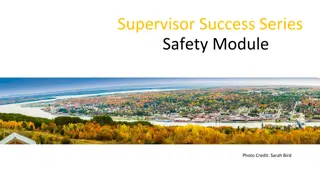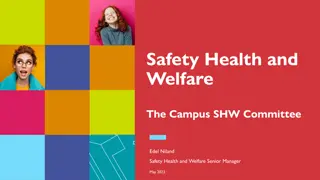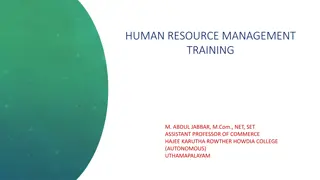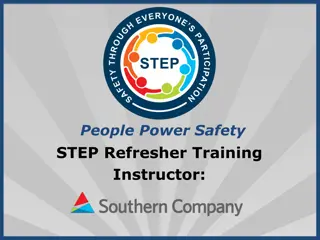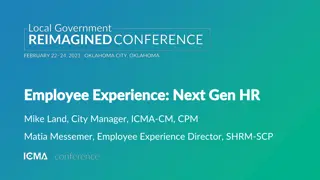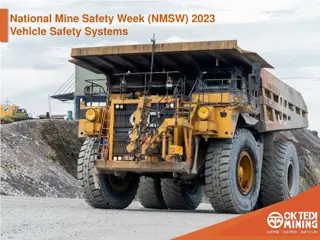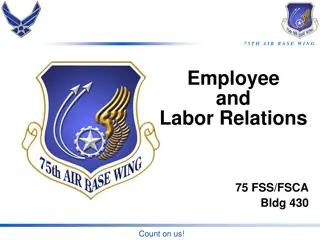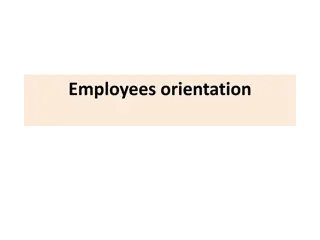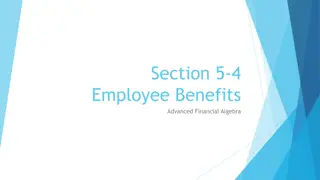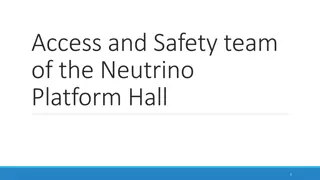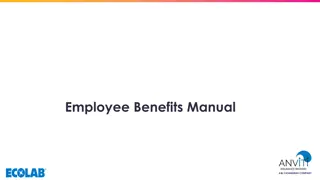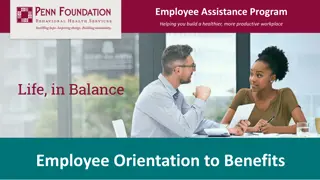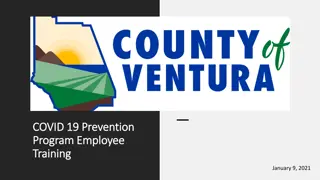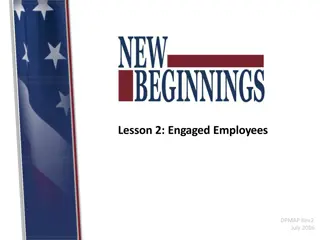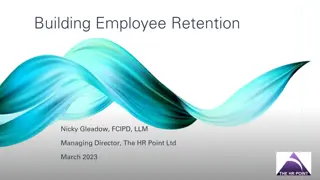Employee Health and Safety Training Guidelines
Detailed training resources covering topics such as employee injuries, OSHA regulations, workers' compensation, and reporting procedures to ensure a safe work environment. The content delves into workers' compensation coverage, work-related injury criteria, reporting guidelines, medical referrals, investigations, and important information for employees. It emphasizes the significance of timely reporting, proper procedures when referring to medical providers, and managing absences and modified duties effectively to minimize disruption and cost in the workplace.
Download Presentation

Please find below an Image/Link to download the presentation.
The content on the website is provided AS IS for your information and personal use only. It may not be sold, licensed, or shared on other websites without obtaining consent from the author.If you encounter any issues during the download, it is possible that the publisher has removed the file from their server.
You are allowed to download the files provided on this website for personal or commercial use, subject to the condition that they are used lawfully. All files are the property of their respective owners.
The content on the website is provided AS IS for your information and personal use only. It may not be sold, licensed, or shared on other websites without obtaining consent from the author.
E N D
Presentation Transcript
Employee Injuries, OSHA & Workers Compensation Subtitle Goes Here Location / Date / Goes Here
What will be Covered: Workers Compensation OSHA Requirements Drug/Alcohol Testing
What is Workers Compensation? Covers work-related injuries / illnesses: > Medical/Rx costs > Partial lost wages after waiting period
When is it work-related/compensable? > > > Accident/Illness sustained in the course of employment Breaks? Lunches? (clocking out/investigation important) Fell at home, then had pain at work? Exceptions: Intoxication/Illegal Drug contributed to incident. Employee willfully intended harm to self/other
Always report injuries/illnesses Do not try to determine compensability - Report near misses too! When to refer to medical provider: Call 9-1-1 in emergency Refer to provider when: EE feels need to leave work (rest, etc.) EE injures others/property (drug test). EE injures self beyond minor first aid. If drug test required, provide form.
Investigations > Alert HR/Safety ASAP (even if no referral). > Document & FIX to prevent future injuries. Reporting to Workers Comp Carrier: Alerts carrier to issue. Ensures immediate investigation (memories fade). Quick employee support. Carrier MAY call you.
Information Employees Should Know Provide Carrier Information (Carrier may contact them) First medical visit to WC provider covered If further visits needed, contact carrier for approval All doctor s notes: Employee send to HR ASAP
Absences and Modified Duty Doctor writes out of work : 1. CALL HR. 2. Time out of work increases cost of WC Insurance(!) 3. HR/carrier can see if doctor has modified duties instead. Doctor says modified duty : 1. CALL HR (if possible RTW immediately). 2. If approved, make sure employee complies.
OSHA-Occupational Safety & Health Act General Duty Clause Employers provide workplace free from recognized hazards likely to cause death or serious physical harm. Safety Information Keep the hazard sheets on chemicals updated. Make sure employees are trained to know where to find them. Notify employees of any specific safety processes. Emergency exits, fire alarms, etc. Immediately correct unsafe behavior.
OSHA-Occupational Safety & Health Act Anti-Retaliation Prohibits discouraging workers from reporting an injury or illness. If an employee reports a concern: 1. Thank them. It is EVERYONE s job to speak up. 2. Fix the issue if possible. 3. Elevate to the appropriate department if you cannot. 4. No action taken? Elevate appropriately. Some safety issues may not be fixable. Get back to employee & explain.
OSHA Reporting Let HR/Senior Management know ASAP... > Fatality must report to OSHA within 8 hrs > In-patient hospitalization 24 hours > Amputation 24 hours > Loss of an eye 24 hours
OSHA posting: Form 300A Location based Information about days missed/lost time Post from February 1 through April 30
OSHA Inspections > Opening Conference Inspection Process: > Paperwork/Recordkeeping > Inspection of Facility > Employee Interviews > Closing Conference > Post Inspection Activities/Follow-Up
Alcohol & Drug Testing When to perform > First medical visit at time of incident. > Injury to others or property. > Reasonable Suspicion: CONTACT HUMAN RESOURCES FIRST. No anonymous or he said / she said . Do not delay. You will transport the employee; Tell them refusal may result in termination.
Supervisor Responsibilities (Safety) Be out there ; do walkarounds. > Model behaviors. Culture of safety. > See safety issue? Point out/correct. > See odd behavior? Talk to employee.
Supervisor Responsibilities (Safety) Accountability > See employee being unsafe? Take aside/correct. > Serious/ongoing safety violations should result in corrective action. > Failure to act = biggest risk.



